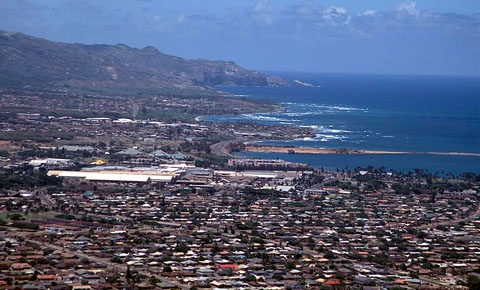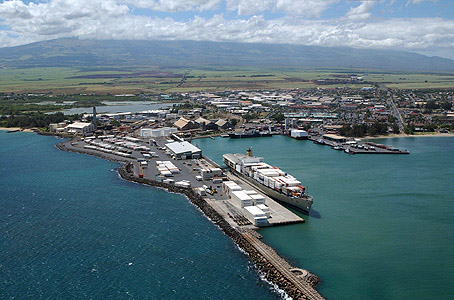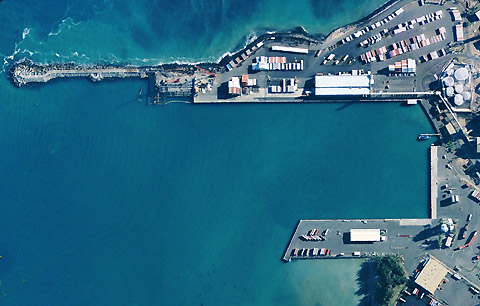www.islandbreath.org ID# 0603-24
SUBJECT: HAWAII SUPERFERRY IN TROUBLE
SOURCE: DICK MAYER dickmayer@earthlink.net
POSTED: 12 December 2006 - 3:00pm HST
Kahului judged reverses decision on Superferry

view of Kahalui, Maui, looking north towards harbor
| Easing the harbor crunch [ Note by Dick Mayer: Aloha, Judge Joel August has reversed his previous Second Circuit Judge Joel August ruled Monday that two of three groups seeking to challenge the state’s environmental statement for improvements at Kahului Harbor do have standing and can pursue their claims. |
SUBJECT: HAWAII SUPERFERRY IN TROUBLE
SOURCE: DICK MAYER dickmayer@earthlink.net
POSTED: 19 November 2006 - 12:00pm HST
Kahului judged too busy for Superferry

by the Associated Press 18 November 2006 in The Honolulu Star-Bulletin | Harbormaster
Steve Pfister did not speak, but he has said it will be difficult
to find berths for all the vessels that need to arrive at the harbor.
Currently three piers are available -- one for ocean-going ships,
one for fuel barges and one for interisland barges and the Superferry. |
SUBJECT: HAWAII SUPERFERRY IN TROUBLE
SOURCE: DICK MAYER dickmayer@earthlink.net
POSTED: 1 November 2006 - 6:00pm HST
Big Island council calls for ferry launch delay

aerial photo of Kahalui Harbor showing main dock and east breakwater
| by
Kevin Dayton on 1 November 2006 in The
Honolulu Advertiser The Big Island County Council yesterday called for a delay in the launch of the Hawai'i Superferry until the state and the company planning the project do more to address concerns about the economic, social and environmental impacts of the project. The 7-1 council vote on a nonbinding resolution means the councils on Kaua'i, Maui and the Big Island have all called for more study before the ferry begins service. The Superferry's first 340-foot-long vessel would offer three-hour crossings from O'ahu to Kahului Harbor on Maui and Nawiliwili Harbor on Kaua'i starting in July. A second vessel will enter service in 2009, expanding routes to Kawaihae on the Big Island. The state is not planning an environmental impact statement for the project, and Hawai'i Superferry Chief Executive Officer John Garibaldi said his company is already doing many of the studies that would go into an EIS. Garibaldi said his company has done traffic studies, developed a whale avoidance policy to protect marine mammals and worked with environmental experts to avoid spreading invasive species. "We're doing things already, being an environmentally friendly and conscientious company," he said. "We continue to talk with council members, we continue to talk with communities and to get feedback from experts in their fields throughout the state of Hawai'i." Among those favoring an environmental impact statement for the project was Karen Rosen, who cited the financial risk to taxpayers from the project. The state is spending $40 million for barge, ramp and apron systems to be installed at the four Superferry ports, including a barge for Kawaihae. The federal government also has approved a $140 million loan guarantee for the company to help finance the cost of building the vessels. Safety and social welfare issues also are raised by the Superferry, which is expected to transport the Army's armored Stryker vehicles to the Big Island for training, Rosen said in written testimony. Gunner Mench, a Kawaihae business owner, opposed the council resolution, calling it an example of "one agency of our government not talking to another." Mench argued that an environmental impact statement is already planned for Kawaihae Harbor in connection with plans to update the harbor master plan. Mench said demanding another impact statement on the Superferry "is essentially redundant." The council resolution warns that Kawaihae Harbor is already under pressure from the steadily increasing volumes of cargo traffic at the port, with increasing numbers of vessels vying for limited harbor space. Superferry service may trigger a reduction in interisland barge service by tying up space now used by Young Brothers Ltd. The resolution also raises concern that the Superferry could spread invasive species and kill whales by striking them. "It seems quite evident that Hawai'i Superferry will have a tremendous impact on many aspects of our environment, and the questions regarding additional tax revenue that will be needed to help support this venture need to be answered," said Kona resident Jeff Sacher in written testimony to the council. The state and Superferry officials have said they will scrutinize cargo to be sure the service does not help spread invasive species. State and federal authorities determined the ferry was not required to conduct an environmental assessment, and legal challenges arguing for an environmental review have been rejected by state and federal courts. However, appeals of those rulings are expected. |
SUBJECT: HAWAII STRYKER BRIGADE
SOURCE: JONATHAN JAY jonathan@dakauai.com
POSTED: 29 October 2006 - 7:30am HST
Court halts all Stryker activities

Strykers deployed in Iraq with anti-mine and urban warfare modifications
by
Mary Vorsino on 28 October 2006 in The
Honolulu Advertiser |
SUBJECT: HAWAII SUPERFERRY IN COURT
SOURCE: DIANA LABEDZ DianaLaBedz@aol.com
POSTED: 25 October 2006 - 3:30pm HST
Judge may ’reconsider’
his Kahului Harbor ruling

Hawaii State Second Circuit Judge Joel August
|
Pau